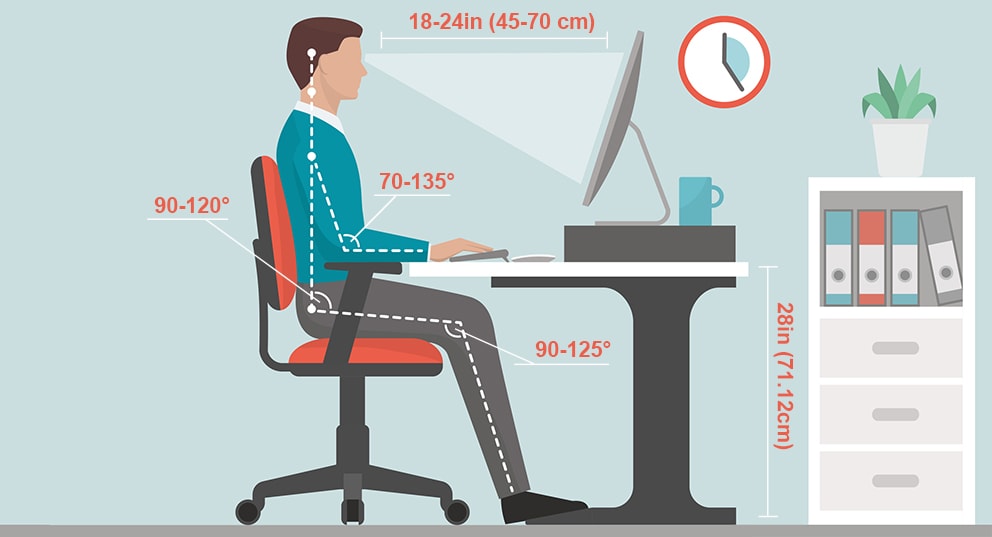Height and Workspace Efficiency

The height of your table and chair is crucial for a comfortable and productive workspace. A well-adjusted setup promotes proper posture, reduces strain, and optimizes your workflow.
Table and Chair Height Impact on Workspace Efficiency, Ideal height study table chair
A comfortable workspace is essential for productivity. The right table and chair height can significantly impact your posture, comfort, and overall efficiency. An ideal setup promotes a neutral spine, reduces muscle strain, and minimizes fatigue, allowing you to focus on your tasks without discomfort.
Examples of Height Combinations for Optimal Workspace
Different height combinations can optimize desk space and workflow for specific tasks.
- Standing Desk: A standing desk with a chair that allows for a comfortable standing height encourages movement and can improve circulation and focus. This setup is ideal for tasks that require frequent movement, such as brainstorming or presentations.
- Traditional Desk: A traditional desk with a chair that allows for a comfortable sitting posture is suitable for tasks that require sustained focus, such as writing, reading, or coding. This setup promotes good posture and reduces strain on the back and neck.
- Adjustable Desk: An adjustable desk allows you to switch between sitting and standing positions, promoting a dynamic workspace. This flexibility is beneficial for tasks that involve both focused work and movement, such as writing, editing, and research.
Designing a Table Layout for Maximum Workspace Efficiency
A well-designed workspace can significantly enhance productivity.
- Ergonomic Chair: Invest in a chair with adjustable features, such as seat height, backrest angle, and armrests. This allows you to customize the chair to fit your body and promote good posture.
- Table Height: Choose a table height that allows your elbows to be bent at a 90-degree angle when sitting. This promotes a neutral spine and reduces strain on your neck and shoulders.
- Monitor Position: Position your monitor directly in front of you, at eye level. This minimizes eye strain and reduces neck fatigue.
- Keyboard and Mouse Placement: Place your keyboard and mouse directly in front of you, within easy reach. This minimizes arm and wrist strain.
- Workspace Organization: Keep your workspace clean and organized. This reduces clutter and distractions, allowing you to focus on your tasks.
Table Height Combinations and Suitability for Tasks
| Table Height (cm) | Chair Height (cm) | Task Suitability |
|—|—|—|
| 72 | 45 | Writing, reading, coding |
| 75 | 48 | Editing, research, graphic design |
| 80 | 52 | Standing work, presentations, brainstorming |
| 85 | 56 | Heavy-duty tasks, assembling, woodworking |
Health and Wellbeing: Ideal Height Study Table Chair

An ideal height study table and chair are not just about comfort; they are essential for maintaining good health and well-being, especially during prolonged study sessions. The right setup can prevent strain and discomfort, while a poorly adjusted setup can lead to various health issues.
Proper Posture and Reduced Risk of Back Pain
Maintaining proper posture while studying is crucial for preventing back pain and other musculoskeletal problems. An ideal height study table allows you to sit with your feet flat on the floor, your back straight, and your shoulders relaxed. This posture promotes good spinal alignment, reducing strain on the back muscles and joints. A comfortable chair with adequate lumbar support further enhances comfort and posture.
Negative Health Effects of Incorrect Setup
Using a study table and chair that are not the correct height can lead to several negative health effects, including:
- Back Pain: Sitting with a slouched posture or with your back unsupported can strain the back muscles and lead to chronic back pain.
- Neck Pain: Looking down at a screen for prolonged periods while sitting in a chair that is too low can strain the neck muscles, leading to pain and stiffness.
- Shoulder Pain: Incorrect posture can also cause shoulder pain, particularly if you are hunched over your work.
- Carpal Tunnel Syndrome: Using a desk that is too high can put pressure on the wrists, leading to carpal tunnel syndrome, a condition that causes numbness, tingling, and pain in the hands.
- Eye Strain: Using a desk that is too low or too high can also strain your eyes, leading to headaches and blurry vision.
Exercises to Combat Prolonged Sitting
Regular exercise is essential for combating the negative health effects of prolonged sitting. Here are some recommended exercises:
- Stretching: Stretching your back, neck, and shoulders regularly can help to improve flexibility and reduce muscle tension.
- Walking: Take regular breaks to walk around and move your body. Even short walks can help to improve circulation and reduce stiffness.
- Strength Training: Strength training exercises can help to strengthen your back and core muscles, improving posture and reducing the risk of injury.
An ideal height study table chair should be a haven of comfort, a sanctuary for focused thought. It’s a constant companion, witnessing late-night study sessions and the quiet joy of discovery. Sometimes, though, a different kind of comfort beckons, a wild embrace like the grizzly bear bean bag chair , where thoughts can wander and anxieties fade.
But returning to the study table, the chair awaits, a steadfast reminder of the path ahead, the journey of learning that continues, even in the quiet hours.
The perfect study table chair should cradle you in comfort, a haven for long hours spent immersed in thought. For those seeking an added touch of personality, the ikea nolmyra chair cover offers a spectrum of styles, allowing you to personalize your workspace.
Yet, even with the most stylish cover, the true comfort lies in the chair’s height, ensuring your posture remains aligned and your mind stays focused.
